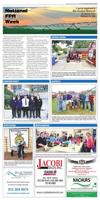Indiana Dept. of Transportation contractor Lutgring Bros. Inc. is scheduled to close S.R. 62 between Kensington and Tandy roads on or after Wednesday, April 17, to complete a culvert replacement near Lanesville.
Hoosier Park in Anderson has now completed the first three weekends of 2024 harness racing with some local horses competing.
James L. (Jim) Kusek, a lifelong resident of Corydon, passed away peacefully Tuesday, March 12, 2024, of heart failure.
Lois Edna Bevins Endris, age 92, of Depauw, Ind., passed away on Tuesday, April 9, 2024, surrounded by the love of her family.
Billy J. Short, 81, of Corydon, died Friday, April 12, 2024, in Corydon.
Robert Brooks Richards, age 93, of New Salisbury, Ind., departed from this world on Wednesday, April 10, 2024.
Calvin Joseph (Red) Davis, 96, of Corydon, Ind., passed away on Monday, April 8, 2024, at Harrison Springs Health Campus near Corydon.
Mary Jane Ehalt, 92, of Georgetown, Ind., met her Lord and Savior on Sunday, April 7, 2024.
An employee in a high-stress technology job observed how his boss always “seemed totally at peace, totally chill no matter how messed up things got.” When one day opportunity presented to ask his boss in private how he maintained his cool, the boss explained, “Someday, someone you love will …



















Commented
Sorry, there are no recent results for popular commented articles.